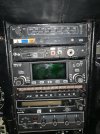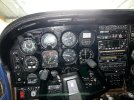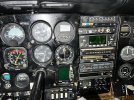MauleSkinner
Touchdown! Greaser!
The only place that doesn’t happen is a simulator.Have you tried flying a box-of-hammers approach in a crosswind?
The only place that doesn’t happen is a simulator.Have you tried flying a box-of-hammers approach in a crosswind?
I'm wondering what avionics is needed to make my 182Q qualified to use for a IFR Checkride?
What make you think it isn’t?
?What make you think it isn’t?



Thanks! Would I need a second HSI/CDI with glide slope too? Is the GPS 175 capable of precision and Non precision approaches or will the radios I have handle what a Garmin GPS 175 won't do?Looks to me you have the equipment, assuming it all works, to do the training and take a checkride. However, if I was you I’d replace the 90 with a WAAS box—Garmin GNC 355 or GPS 175. In any event I’d also sit down with your CFII and have him/her go over your questions and chart out a path.
Your radios give you ILS (precision approach) and LOC/VOR (non-precision approach) capability—plenty for your checkride. The 175 will also give you LPV (technically not a precision approach but will count as a precision approach per the ACS on a checkride as long as the DA is low enough) and of course GPS non-precision approach capability. My recommendation to replace your 90 is more about practical IFR utilization of the NAS after you get your ticket— WAAS will do that.Thanks! Would I need a second HSI/CDI with glide slope too? Is the GPS 175 capable of precision and Non precision approaches or will the radios I have handle what a Garmin GPS 175 won't do?
Thanks for the Help, tsts4! I sure do appreciate it. I'm going to do some more looking in to the Garmin GPS-175. That's probably what I'll go with. Would there be any benefit in putting a nice used GNS430W or GNS530W over the GPS-175?Your radios give you ILS (precision approach) and LOC/VOR (non-precision approach) capability—plenty for your checkride. The 175 will also give you LPV (technically not a precision approach but will count as a precision approach per the ACS on a checkride as long as the DA is low enough) and of course GPS non-precision approach capability. My recommendation to replace your 90 is more about practical IFR utilization of the NAS after you get your ticket— WAAS will do that.
Looks like the SL30 is your only VOR/LOC/ILS radio. A GNS will give you a second one in case of a failure. On the other hand, the GNS is a lot less repairable and is on the verge of going obsolete. But other than the NAVCOM the GPS175/GNX375/GNC355 is way more modern and even easier to fly.Would there be any benefit in putting a nice used GNS430W or GNS530W over the GPS-175?
Here’s the rule:I'm doing a lot of research online, and I'm new BTW. I'm finding lots of new and older material to learn from for free before I start a tab with the pros. Makes me look sharp.
Thing is that I think some of the instruments used and explained in the free online archives are out of use on the planes these days or going out of use. It may be useful to learn how to use them all since who knows what's going to be in every plane or airport, eh.
Which instruments going out of service these days, and what's the absolutely necessary to fly with for approach/depart? Thanks
Just because its IFR capable doesn't mean it has the Avionics need for a IFR check ride.
The HSI looks like a King 525 so I'd guess that it would work with a GPS upgrade. I'd also guess that it is currently hooked up to the SL30, which brings us back to square one.The concern I would have is that with any of the GPS upgrades is if the the HSI/CDI is reusable with them, I am going to guess it is not and you may need CDI also.
But perhaps only until the next time FIS or MTH goes OTS?Here’s the rule:
(2) Two-way radio communication and navigation equipment suitable for the route to be flown.
Here’s a route where all you would need is ADF.
KEYW FIS B646 MTH KMTH
Are you saying that a VOR is just going to be turned off mid flight with no notice?I've heard and read that statement several times from various folks, including a local CFI. In a plane w/out an approved panel GPS navigator, but in a plane only equipped with a single VOR/CDI/GS, wouldn't an ILS, a LOC, and a VOR approach meet the "three different types of approaches" requirement for the checkride and currency? I'm not suggesting that a plane so equipped would be ideal for actual useful IMC flight as VORs are increasingly decommisioned and GPS approaches increasingly become the norm, but couldn't one at least complete the training and checkride for an IR?
Asking for a friend...
Anything WAAS is gonna be $5k plus install. A KLN can be had for $1500 and installed for a few hundred more.All the GPS can output the signals needed by the King HSI since it was the standard for several decades. The plane in question is IFR capable and check ride worthy (assuming the KLN90 is up to date). You can shoot a non-precision GPS and VOR approach, and a precision ILS.
Nice panel, a 175 or 650 in place of the KLN90 would make life much easier and bring you WAAS. Since ILS precision approaches are getting far and few between, the utility of the airplane will greatly increase with a WAAS GPS.
Yes, the 175 (lower end of the dollar amount) brings a tremendous amount of utility compared to a KLN94. The latter can only do non-precision approaches. In many places the difference may be only a few hundred feet, but it won't drive the vertical guidance at all, even to the higher minimums of an LNAV approach if I recall correctly.you
Anything WAAS is gonna be $5k plus install. A KLN can be had for $1500 and installed for a few hundred more.
Does that extra $4-6k add that much value for PPL that might see 100hours of flying a year?
I use GTN 650 which provides bot precision and none precision. I have it connected to my PortaPilot autopilot. Very easy to manage since all is transparent, and fewer steps required. You don’t need to have a source switch nor GPSS as to do with the old autopilot.Looks like the SL30 is your only VOR/LOC/ILS radio. A GNS will give you a second one in case of a failure. On the other hand, the GNS is a lot less repairable and is on the verge of going obsolete. But other than the NAVCOM the GPS175/GNX375/GNC355 is way more modern and even easier to fly.
Even a 1-axis (wing leveler) is a tremendous boon in IMC/cross-country flying. Went from a 2-axis coupled autopilot in one aircraft to a wing leveler in a current one. Initially thought it was barely worth having, turns out it's about 85% of all the autopilot one needs if current and proficient.If you don’t have WAAS you’ve limited yourself tenfold.
I’d want at minimum:
A glide slope
WAAS GPS
2-axis autopilot
If you’re going to fly IFR, you can’t go without the above mentioned tools imho.
Agree, WASS GPS units are very accurate. I’m amazed at the lateral accuracy of the PortaPilot (AP) it typically brings my C172M to within 60 feet of the center line at the DA, be it ILS/LOC or RNAV. It relies on a WASS GTN 650. Can’t think of any other autopilot that is this accurate.All the GPS can output the signals needed by the King HSI since it was the standard for several decades. The plane in question is IFR capable and check ride worthy (assuming the KLN90 is up to date). You can shoot a non-precision GPS and VOR approach, and a precision ILS.
Nice panel, a 175 or 650 in place of the KLN90 would make life much easier and bring you WAAS. Since ILS precision approaches are getting far and few between, the utility of the airplane will greatly increase with a WAAS GPS.
